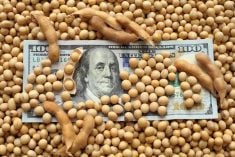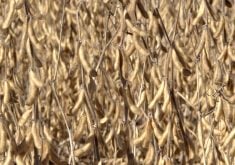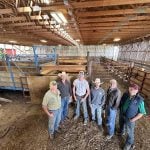MarketsFarm — Labour shortages caused by the COVID-19 pandemic, high feed costs and lower prices posed constant threats to Canada’s hog industry in 2021. Nevertheless, pork appears to be in a good spot entering 2022, according to two analysts.
“2021 was not the best, but not the worst,” said Tyler Fulton, director of risk management for HAMS Marketing Services at Headingley, Man. “We still had a ton of volatility and a lot of uncertainty associated with supply chain issues, feed costs and the implications of the (COVID-19) pandemic on the whole supply chain.”
Read Also

U.S. grains: Soy hits four-month high on hopes for China trade deal
U.S. soybean futures jumped to their highest level in more than four months on Monday on hopes that China will resume buying American supplies after President Donald Trump said the countries were set to reach a trade deal during his trip to Asia this week.
Brad Marceniuk, provincial livestock economist for the Saskatchewan government, wrote in an email that hog prices currently have an index in the low-170s per 100 kilograms (ckg), above long-term averages. Costs of feed, production and freight are also raising hog prices.
“Depending on a producer’s location in Western Canada and availability, if any, of feed wheat or barley, feed costs are up 40 to 50 per cent from a year ago. Many producers are importing corn from the (United States) which is adding additional freight charges,” he wrote.
“Canadian hog producers were doing fine over the summer, but things turned negative in October when slaughter weight hog prices declined significantly and feed costs continued to rise.”
Both Fulton and Marceniuk agree the most pressing issue facing the Canadian hog industry is the sharp reduction in the labour force due to the Omicron COVID-19 variant, from which the industry hasn’t yet fully recovered. Meat packing plants have also had additional costs after implementing COVID-19 prevention measures at the workplace.
“We don’t have a perfect way of measuring the degree which U.S. packers and Canadian packers have dialed back production levels, but I think it’s reasonable to say levels went down five to 10 per cent and they threaten to go down even further,” Fulton said.
In 2021, for the first time in many years, Canada’s largest buyer of pork products wasn’t China. Pork products exported to China dropped nearly 55 per cent to 260 million kg (from January to November) compared to 2020.
However, Canada recovered much of the decline due to increased exports to the U.S. (370 million kg, up 30 per cent), Mexico (175 million, up 87 per cent) and the Phillipines (117 million, up 226 per cent).
“Recent reports have indicated that hog production in China has rebounded close to pre-(African swine fever) levels. Hog prices in China have been depressed for six months are more. This has translated to significantly reduced pork imports,” Marceniuk wrote.
According to Canada Pork, pork output in China totalled 53 million tonnes in 2021, close to the same total as 2017 before ASF’s still ongoing spread through China.
“This has likely helped North American pork cutout values from plummeting, but (they have) still been reduced. Domestic demand for pork in Canada and the U.S. has remained strong, likely due to a combination of reduced hog supplies in the U.S. in 2021, an improving economy, and higher prices of beef and chicken relative to pork,” Marceniuk added.
Nearby Chicago Mercantile Exchange (CME) contracts for lean hogs are near highs, as are pork cutout prices, and the high costs of feed will only keep pork prices elevated in 2022. According to Fulton, it leaves the Canadian pork industry in good shape.
“We have a setup in the market where the supply still seems constrained for at least the next eight to 10 months,” he said. “But we’ve got excellent domestic demand and the prospect for really solid export demand, as well.”
— Adam Peleshaty reports for MarketsFarm from Stonewall, Man.













